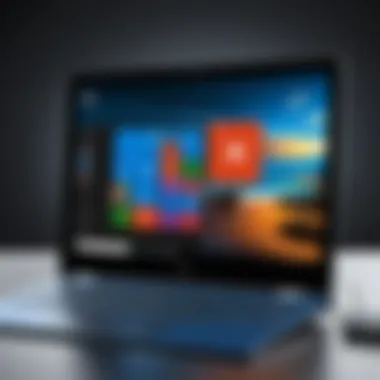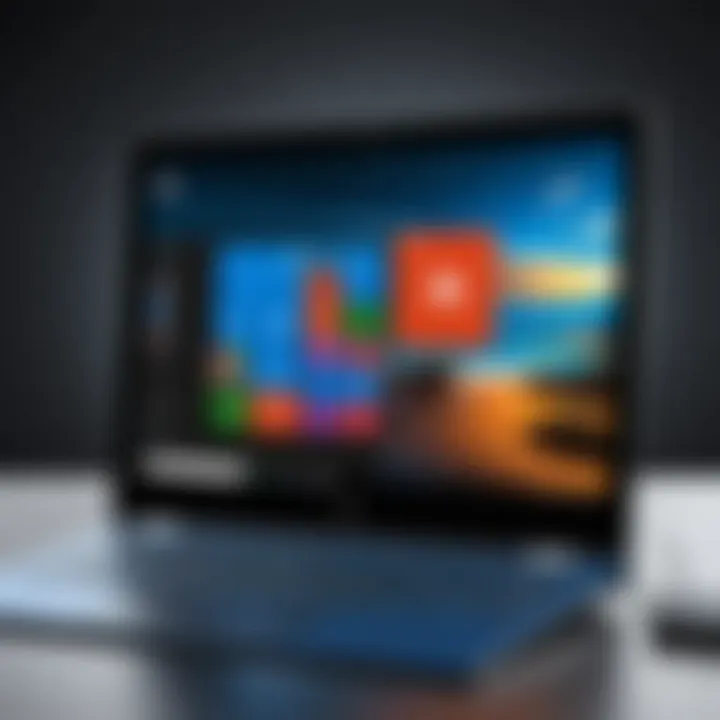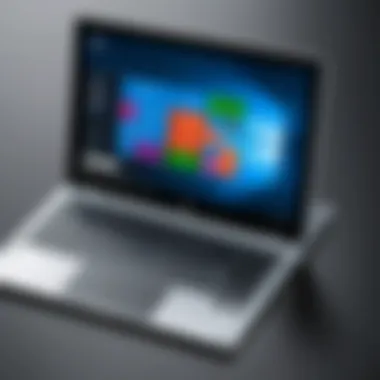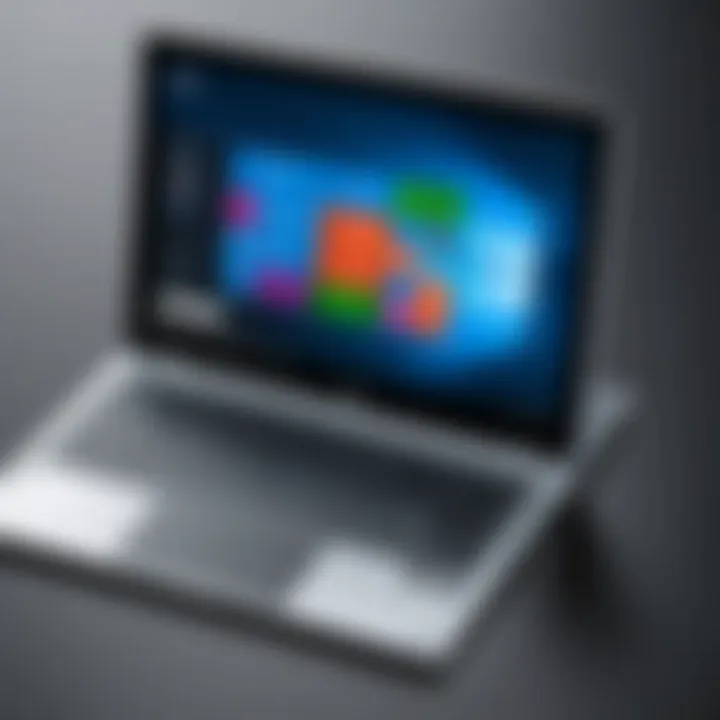Essential Guide to Buying and Downloading Windows 10


Intro
Purchasing and downloading Windows 10 involves a variety of steps, ensuring that users are informed and prepared for the transition. This guide aims to cover all essentials, from understanding performance metrics to installation tips and troubleshooting methods. With a focus on technical details, this article will serve as a useful resource for information technology professionals and savvy tech enthusiasts.
Performance Metrics
Performance metrics are critical when considering any operating system. Windows 10 has been recognized for its optimizations and ability to deliver a better user experience than previous versions.
Benchmarking Results
When reviewing benchmarks, Windows 10 shows significant improvements in areas such as boot speed and application launch time. Results from various testing platforms indicate that users may experience faster load times when launching applications like Microsoft Office or web browsers such as Google Chrome. For IT professionals, this means increased efficiency when deploying systems or managing updates across multiple machines.
Speed and Responsiveness
In terms of speed and responsiveness, Windows 10 offers an intuitive experience. Features such as the Task Manager are designed to provide real-time insights into system performance. This allows users to monitor CPU and memory usage effectively. On average, users may notice that Windows 10 responds more swiftly to commands and tasks, especially when coupled with SSD storage solutions.
Usability and User Experience
Usability is an often overlooked aspect of a new operating system. Windows 10 aims to address common concerns users have during the setup and installation phase.
Ease of Installation and Setup
The installation process for Windows 10 is designed to be straightforward. Users can opt for a clean installation or an upgrade from previous versions. The accompanying prompts guide users through partitioning their hard drives and choosing the correct installation settings. Clear instructions and a user-friendly interface enhance the experience.
Interface Design and Navigation
Interface design in Windows 10 has received positive feedback. The Start Menu, combined with Live Tiles, allows users to customize their workspace efficiently. Users can pin frequently used applications for quick access. Navigation is further improved with features like Task View, giving users a clear overview of open windows.
Guy C. Smiley once said, "A well-structured interface is essential for a productive experience."
Closure
Understanding Windows
Understanding Windows 10 is crucial for anyone intent on navigating the complexities of modern computing. This operating system is not just a basic update from previous versions; it represents a significant evolution in user experience, security, and overall capability. For IT professionals and tech enthusiasts, grasping the essentials of Windows 10 will unlock its full potential and help in troubleshooting or optimizing its use in various environments. This section will cover the overall architecture, essential features, and system requirements that one must consider before purchasing or downloading Windows 10.
Overview
Windows 10 was developed by Microsoft as the successor to Windows 8.1, officially released on July 29, 2015. The operating system aims to unify various devices under one ecosystem, from PCs to tablets, and even smartphones. By adopting a model where updates occur regularly, Windows 10 offers an increasingly refined interface and improved security features. Users benefit from a more intuitive design, making it easier to operate complex tasks while maintaining productivity.
The user interface is built around the concept of the Start Menu, which combines traditional elements from previous Windows versions with modern tiles. This allows for a seamless blend of productivity and ease of access to applications. Understanding this interface is the first step in using Windows 10 effectively.
Key Features
Windows 10 comes equipped with various features designed to enhance the user experience. Some of the more prominent ones include:
- Cortana: Microsoft’s virtual assistant capable of helping with tasks, reminders, and web searches.
- Microsoft Edge: A new web browser designed to replace Internet Explorer, offering improved speed and better security.
- Windows Hello: A biometric login feature that allows users to access their devices using facial recognition or fingerprints.
- Virtual Desktops: This feature enables users to create multiple desktop environments, allowing for a more organized workspace.
- Universal Windows Platform (UWP): A development platform that allows applications to run on any Windows device.
These key features reflect Windows 10's focus on both usability and versatility, positioning it as a competent choice for both general users and professionals in technology fields.
System Requirements
The system requirements for Windows 10 differ depending on the edition but generally include:
- Processor: 1 GHz or faster with at least 2 cores on a compatible 64-bit processor.
- RAM: 4 GB minimum for 64-bit; 2 GB for 32-bit.
- Storage: 64 GB or larger storage device.
- Graphics Card: Compatible with DirectX 9 or later with a WDDM 1.0 driver.
- Display: At least 800 x 600 resolution.
Understanding these system requirements is vital before purchasing Windows 10. It ensures that users have compatible hardware that meets the necessary criteria for optimal performance. Keeping this information at hand aids in avoiding installation-related issues later on and prepares users for a smoother transition to this operating system.
Licensing Options for Windows


Understanding the different licensing options for Windows 10 is essential for making an informed purchase decision. Each type of license offers unique benefits and potential limitations, impacting your experience, especially in terms of support, updates, and deployment flexibility. Whether you are an IT professional managing multiple installations or an individual user, the choice of license will affect how Windows 10 functions in your specific context. Let's explore the three primary types of licensing options available: Retail License, OEM License, and Volume License.
Retail License
A Retail License for Windows 10 provides the most flexibility to the user. This license is designed for individual consumers and businesses who purchase Windows 10 directly from authorized retailers or the Microsoft Store. One of the main advantages of a retail license is that it can be transferred from one computer to another. This means if you upgrade your hardware or get a new device, you can reinstall your copy of Windows 10, provided you deactivate it on the old machine.
Additionally, a retail license typically comes with a full version of the software and access to technical support from Microsoft. In many cases, users can also receive digital upgrades and updates. This can be especially important for users who prefer to stay current with the latest features and security patches.
OEM License
An OEM License stands for Original Equipment Manufacturer License. This type of license is usually pre-installed on new computers, specifically when purchased from manufacturers like Dell, HP, or Lenovo. While an OEM license can be less expensive than a retail license, it comes with restrictions.
Most importantly, an OEM license is non-transferable. If your machine fails or you choose to replace it, you cannot move this license to another device. This can limit flexibility, especially for those who may want to upgrade systems frequently. It's also worth noting that OEM licenses typically do not provide the same level of technical support from Microsoft; instead, users must rely on the manufacturer for assistance.
Volume License
A Volume License is tailored for organizations, educational institutions, and businesses requiring multiple installations of Windows 10. This type of license allows companies to purchase licenses in bulk, ensuring a streamlined deployment across numerous devices. The key advantage here is that it makes management easier and helps maintain compliance with software regulations.
Volume Licensing often comes with additional benefits such as software assurance, which includes various support options, upgrades, and ability to manage systems efficiently. Companies can use their volume license keys to install Windows 10 on all networked machines, facilitating updates and security roll-outs.
Volume Licensing is ideal for businesses aiming to minimize costs while maximizing deployment efficiency, as it streamlines the management of software across many systems.
Purchasing Windows
Purchasing Windows 10 is a pivotal step for individuals and organizations looking to upgrade their computing experience. This section covers the fundamental aspects of obtaining Windows 10 legitimately, as well as the benefits, considerations, and potential pitfalls that come with each purchasing method. Knowing the right channels and options can significantly affect the user's experience, ensuring not only compliance with licensing but also providing access to updates and customer support.
Official Microsoft Store
Buying Windows 10 directly from the Official Microsoft Store guarantees authenticity and reliability. Users will find different versions tailored to various needs, whether it is for gaming, business, or general home use.
- The purchase process is straightforward; users select their desired edition and can choose between a download option or a physical copy shipped to their address.
- When transactions occur through the Official Store, customers often enjoy special promotions or bundle offers that may not be available elsewhere.
- Additionally, purchasing from Microsoft ensures you receive genuine software that is eligible for updates and official support, which can be crucial in resolving technical issues.
Those interested can visit the official site to explore the latest offers and details about each edition.
Authorized Retailer Options
Authorized Retailer Options provide a flexible alternative for those who prefer shopping in person or want to compare prices. Retailers such as Best Buy or Newegg partner with Microsoft to sell Windows 10, offering surges in convenience and sometimes reduced pricing. However, users must be aware of a few considerations:
- While these outlets offer legitimate versions, it is essential to confirm that the retailer is authorized to prevent possible counterfeit software.
- Pricing may vary, and some retailers might offer seasonal discounts or bundle deals with hardware, making it beneficial to shop around.
- Additionally, purchasing from authorized retailers typically includes a physical product key or a digital code, which is essential for installation and activation.
In these cases, it is advisable to check return policies and warranty options, as they can differ across retailers.
Third-Party Resellers
Third-Party Resellers offer yet another avenue for acquiring Windows 10, often at competitive prices. Websites like Amazon or eBay list various editions, sometimes at lower costs than official sources. However, caution should be exercised in these instances:
- The legitimacy of software from third-party resellers can be questionable. It is critical to verify seller ratings and read customer reviews to avoid purchasing counterfeit licenses.
- Users should also check if the product key provided will allow for activation without issues.
- Remember that installing software from dubious sources may lead not only to missing out on critical updates but also expose systems to security risks.
Downloading Windows
Downloading Windows 10 is a critical aspect of the purchasing process that should not be overlooked. In today’s digital world, the method of acquiring your software can significantly impact the experience during installation and overall system performance. Understanding how to effectively download Windows 10 ensures that users can access a legitimate copy, avoid potential malware issues, and participate in a seamless installation process.
The methods available for downloading Windows 10 offer flexibility and convenience, allowing users to choose what best fits their comfort level and technical capability. Each option presents unique advantages and considerations that cater to different user needs. Especially for IT professionals and tech enthusiasts, knowing the right approach to download Windows 10 can optimize the installation experience and maintain system integrity.
Using the Media Creation Tool
The Media Creation Tool is a powerful utility provided by Microsoft that facilitates the downloading and installation process of Windows 10. This tool enables users to create installation media, making it a favored choice among many. The primary benefit of using the Media Creation Tool lies in its ability to customize the download experience.
With this tool, users can:
- Download Windows 10 directly from Microsoft’s servers, ensuring the latest version.
- Create a bootable USB drive or DVD for installation, which allows for installation on multiple devices.
- Upgrade existing Windows installations directly, preserving files and settings.


To use the Media Creation Tool, simply download it from the official Microsoft website, run the application, and follow the prompts. The process is user-friendly and involves selecting whether to upgrade or create media. Users must ensure they have sufficient space on their target drive for the download to succeed.
Direct Download from Microsoft Website
Another straightforward method for downloading Windows 10 is through the official Microsoft website. This option is ideal for users seeking a quick and uncomplicated download experience. The website allows users to select their desired Windows 10 version, choose between 32-bit or 64-bit versions, and download the system directly to their device.
The steps for direct download include:
- Visiting the official Microsoft Windows 10 download page.
- Selecting the version according to system capabilities.
- Following the on-screen prompts to finalize the download.
This method prioritizes security and ensures that users receive authentic software from a reliable source. However, it lacks the installation media creation feature of the Media Creation Tool, which might be limiting for those who wish to install on different devices in the future.
Installation Media Options
After acquiring the Windows 10 files, users can utilize several options for installation media. These options cater to all levels of technical expertise and include:
- USB Drives: Creating a bootable USB drive is one of the most recommended methods due to its speed and efficiency. Once users create the media using the Media Creation Tool, they can easily use the USB for installation.
- DVDs: For those preferring physical media, burning the downloaded ISO file onto a DVD remains a sound choice, albeit slower compared to USB solutions.
- Network Booting: In enterprise environments, options like PXE (Preboot Execution Environment) allow users to install Windows directly over a network, a method essential for large-scale installations.
Each method comes with its own set of requirements and potential hurdles; hence, users should assess their situation before proceeding.
"Choosing the right download method is crucial for setting a strong foundation for your Windows 10 installation."
Installation Process
The installation process of Windows 10 is critical. It is not just about getting the system up and running; it sets the foundation for the user experience that follows. A smooth installation not only ensures that the operating system functions well, but it also lays the groundwork for future updates and enhancements. Understanding the installation steps can save time, reduce errors, and enhance overall efficiency for users, especially for those in the IT field.
Preparation Steps
Before diving into the installation of Windows 10, proper preparation is essential. This involves confirming system compatibility, securing data backups, and ensuring you have the necessary installation media.
- Check System Requirements: Ensure your computer meets the minimum hardware specifications. Windows 10 requires a 1 GHz processor, 1 GB RAM for 32-bit or 2 GB for 64-bit systems, and at least 16 GB of available storage.
- Backup Important Data: It is crucial to back up sensitive files and documents. Use external hard drives or cloud storage solutions to safely store your data.
- Create Installation Media: Use the Media Creation Tool to create a USB drive or burn a DVD. This media will be crucial during the installation.
- Note Product Key: If you have a license key, make sure it is readily available, as it will be required during activation.
These steps help ensure that the installation can proceed without hitches.
Step-by-Step Installation Guide
This section outlines the detailed steps to install Windows 10 using the installation media.
- Insert the Installation Media: Plug in your USB drive or insert the DVD into the computer.
- Restart the Device: Reboot your computer and access the BIOS or UEFI settings to adjust the boot order. Make sure the USB or DVD drive is first in line.
- Start the Installation: Once the system boots from the installation media, select your language, time, and keyboard preferences, then click "Next."
- Install Now: Click the "Install Now" button. You may be asked to enter your product key if you have one or select "I don’t have a product key" for later input.
- Choose Installation Type: You will see the options for an upgrade or a custom installation. Select "Custom: Install Windows only (advanced)" for fresh installations.
- Choose Drive: Select where to install the system. If needed, format the drive or create partitions according to your requirements.
- Complete the Installation: Follow the onscreen instructions for setting preferences. Windows 10 will install, which may take some time. Your computer may restart several times during this period.
By following these steps methodically, users can successfully install Windows 10 without significant issues.
Activation Procedure
Activating Windows 10 is crucial. This process verifies that your copy is genuine and not used on multiple devices contrary to Microsoft’s licensing policy.
- Access Activation Settings: Navigate to Settings > Update & Security > Activation.
- Enter Product Key: If you have a product key, click "Change product key" and enter it. If not, select the option to purchase a digital license.
- Activate: Click "Activate" and the system will check your key and complete the process. An internet connection is required for online activation.
- Troubleshooting: If activation fails, use the built-in troubleshooter to identify issues. Users can also contact Microsoft support for unresolved problems.
The activation ensures that the user gets all system updates and features, which is highly beneficial for security and performance.
Common Installation Issues
The installation of Windows 10 is generally straightforward, but users may encounter various challenges that can disrupt the process. Recognizing the most common installation issues is vital for ensuring a smoother experience. Understanding these problems can save time and frustration, and improve overall system performance. This section addresses three prevalent categories of issues: error messages, boot issues, and driver problems.
Error Messages
During the Windows 10 installation process, error messages can appear for a variety of reasons. Some common error codes include 0x80070003 and 0x80246007. These errors can stem from corrupted installation files, hardware incompatibilities, or insufficient disk space.
To troubleshoot these issues, consider the following:
- Check Disk Space: Ensure that your installation drive has adequate space. Windows 10 typically requires around 20GB for installation.
- Use the Media Creation Tool: This tool can help you download the installation files again, ensuring they are not corrupted.
- Seek Help: Microsoft’s official support page provides detailed guidance for specific error codes. Utilizing these resources can lead to effective solutions.


"Error messages can often seem daunting, but understanding their meaning can help users resolve them efficiently."
Boot Issues
Boot issues can occur after installation, leading to a failure to start Windows 10. This can be caused by improper BIOS settings, failed installations, or hardware issues. Users might see a blue screen with a message like "Your PC ran into a problem".
To address boot issues, users should:
- Access BIOS Settings: Ensure that the boot order prioritizes the correct drive.
- Perform Startup Repair: Using installation media to access repair options can resolve many boot-related problems.
- Check Hardware Connections: Loose cables or components can prevent the system from booting properly.
Identifying the root of the boot issue early can save significant time in troubleshooting.
Driver Problems
Drivers play a crucial role in how Windows 10 communicates with hardware. If there are issues with drivers, a user may face problems such as crashes or non-functional devices after installation. Common driver-related messages include "Device not recognized" or "Driver not installed."
To resolve driver problems:
- Update Drivers: Once Windows is installed, ensure that all drivers are updated. Visit the manufacturer’s website to find the latest versions.
- Use Device Manager: Accessing the Device Manager can help users identify whether any drivers are not functioning properly.
- Reinstall Drivers: Sometimes, reinstalling a specific driver can rectify issues encountered during installation.
Driver-related issues can be complex but are often manageable with the right approach and tools.
Updating to Windows
Updating to Windows 10 represents a crucial step for both individual users and enterprises seeking to enhance their operating environment. Given the rapid pace of technological advancement, staying current with operating systems is vital to maximize performance and security. Windows 10 introduces numerous features and improvements over its predecessors, including better system performance, enhanced security measures, and a more user-friendly interface. Understanding this process ensures a smooth transition and minimizes potential disruptions.
Eligible Upgrade Paths
When considering an update to Windows 10, it is essential to identify the various upgrade paths available. The method of upgrading depends largely on the user's current version of Windows and licensing type. Some common upgrade paths include:
- From Windows 7 or Windows 8.1 to Windows 10: Users can upgrade directly if they have genuine copies of Windows 7 or 8.1. This was especially significant during the free upgrade offer that was available until late 2016. While the official offer has ended, many still find that system checks may still permit upgrades.
- Enterprise Environment: Businesses using Windows 7 or Windows 8.1 can opt for the Windows 10 Enterprise edition. This requires careful consideration of volume licensing and IT support capabilities.
- Clean Installation Option: Users can choose a clean install of Windows 10. This path involves backing up their data, wiping the existing operating system, and then installing Windows 10 fresh.
Selecting the right upgrade path can ensure that users retain necessary data and applications while achieving the benefits offered by Windows 10.
Backup Requirements
Before proceeding with an upgrade, attention must turn to backup requirements. Data loss during the update has the potential to be detrimental, especially for businesses. Here are some key points to consider before starting the upgrade process:
- Full System Backup: It is advisable to create a full backup of your current system, including all files and configurations. This can be accomplished using built-in tools like Windows Backup or third-party software solutions.
- Cloud Storage or External Hard Drives: Store backups in a secure location, whether in the cloud or on an external hard drive. Ensuring accessibility and safety is pivotal should any issues arise.
- Ensure Backup Completeness: Verify that the backup is complete and functional. Testing restoration from backup can prevent headaches later.
Having a comprehensive backup minimizes the risks associated with the updating process.
Post-Upgrade Considerations
Once the upgrade has successfully completed, there are several factors to evaluate to ensure an optimized experience with Windows 10:
- System Updates: Immediately after the upgrade, check for any pending updates. Microsoft regularly releases patches and improvements that enhance system security and performance.
- Familiarization with Settings: Windows 10 features a new settings interface. Take time to explore and adjust settings to personal preferences, focusing on security and privacy settings.
- Compatibility Checks: Ensure that all essential software is functioning properly on the new operating system. Certain applications may require updates to maintain compatibility.
- Performance Monitoring: After the update, keep an eye on system performance. Address any abnormalities promptly, such as slow boot times or application crashes.
By paying attention to these post-upgrade considerations, users can effectively manage their new environment and capitalize on the advantages that Windows 10 has to offer.
End
In the context of this article, the conclusion serves as a crucial summary of the various facets related to purchasing and downloading Windows 10. Each element, from licensing choices to installation processes, plays a significant role in ensuring users can smoothly transition to this operating system. Emphasizing these aspects gives readers a systematic overview that facilitates informed decision-making and minimizes potential obstacles.
Final Thoughts on Windows
Windows 10 represents a substantial step forward in operating system technology. Its versatility caters to the needs of various user demographics, from casual users to IT professionals. The integration of features like the Start Menu, virtual desktops, and enhanced security protocols makes it a compelling choice for many.
Moreover, the user interface is streamlined and designed for productivity, which can increase efficiency in work environments. While there are avenues for improvement, especially in areas concerning updates and system requirements, the platform effectively addresses many legacy issues present in earlier versions. Being informed about both the advantages and challenges is key to utilizing Windows 10 effectively.
Future Updates and Support
Considering the nature of technology, anticipating future updates and ongoing support is vital. Microsoft is committed to releasing updates that enhance system performance and security. Regular major updates, along with cumulative updates, ensure users receive the latest features and patches.
Staying updated not only maximizes the functionality of Windows 10 but also guards against vulnerabilities that might be exposed over time. Therefore, it is important for users to develop a habit of regularly checking for updates. Support from the community, such as forums on Reddit, or official channels at Microsoft can also provide ongoing help.
"Staying updated with the latest version of Windows not only improves performance but is essential in maintaining security standards."



